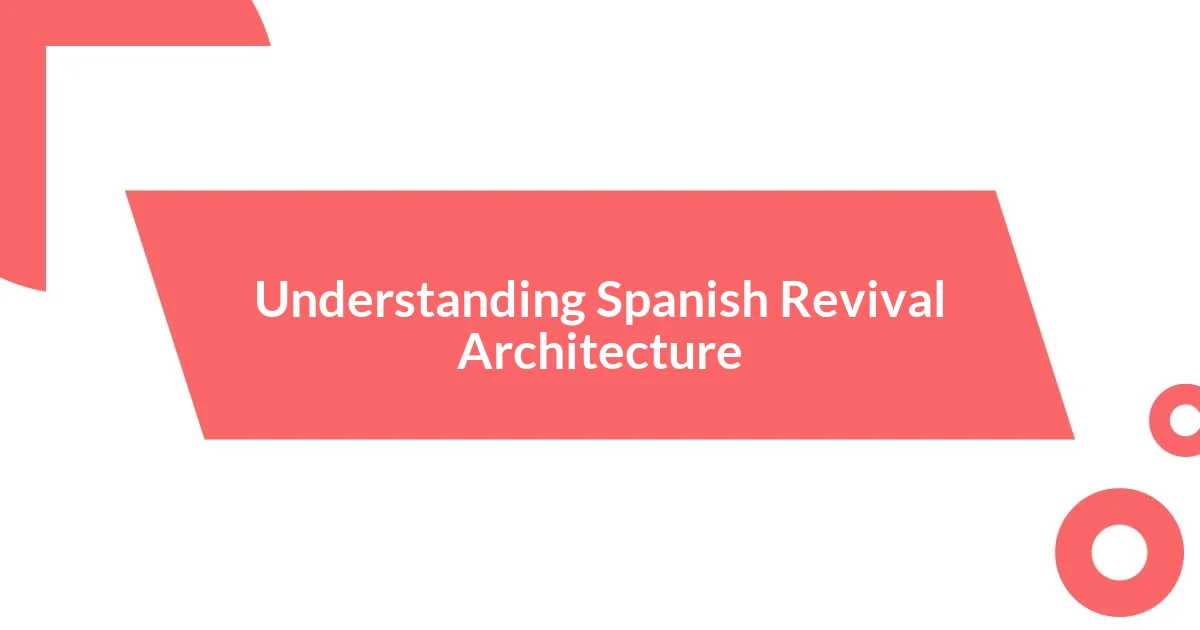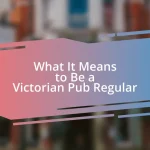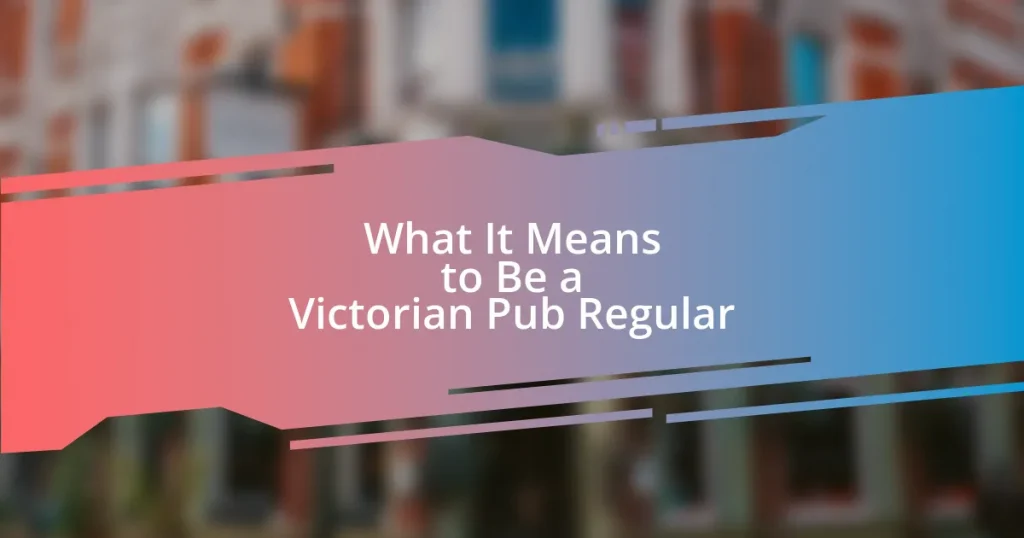Key takeaways:
- Spanish Revival Architecture combines elements from Spanish colonial, Moorish, and Mission Revival styles, emphasizing symmetry, intricate detailing, and a seamless connection to nature.
- Key characteristics include vibrant ornamental tiles, arched doorways and windows for natural light, and terracotta roof tiles that create a warm atmosphere.
- Influential architects such as Bertram Goodhue and Julia Morgan shaped the movement, creating structures that blend historical roots with modern sensibilities, exemplified by notable buildings like the Mission Inn and Santa Barbara Courthouse.

Understanding Spanish Revival Architecture
Spanish Revival Architecture is a captivating blend of historical influences, drawing from Spanish colonial, Moorish, and even Mission Revival styles. I remember stepping into a beautifully restored Spanish Revival home, where every arch and tile whispered stories of the past. Isn’t it fascinating how architecture can evoke such an emotional response?
Honestly, the intricate detailing in Spanish Revival structures always mesmerizes me. From the colorful tiles that adorn the facades to the clay roof tiles that remind us of sunny Mediterranean landscapes, each element serves a purpose beyond aesthetics—it creates a sense of place and tranquility. When I think about how these buildings add character to their surroundings, I can’t help but wonder how they’ve shaped the communities they’re part of.
One of the most striking aspects I’ve found is the strong emphasis on symmetry and form, which creates a rhythm that feels harmonious and inviting. This architectural style often reflects the natural environment, blending indoor and outdoor spaces seamlessly. Have you ever felt like you could simply step out of a Spanish Revival home and into a sun-drenched courtyard? That connection to nature isn’t just a design choice; it’s part of what makes these buildings so enchanting.

Key Characteristics of Spanish Revival
Spanish Revival architecture is immediately recognizable due to its signature features. The use of ornamental tiles, often painted in vibrant hues, creates stunning focal points. I recall walking through a Spanish Revival neighborhood, where each home showcased unique tile patterns that seemed to tell their own stories. It’s like every entryway offered a little glimpse into the soul of the house.
Another notable characteristic is the incorporation of arched doorways and windows. I find these arches not only aesthetically pleasing but also practical; they invite in natural light and create a welcoming atmosphere. While exploring an old estate once, I marveled at how the arches framed the views, turning ordinary scenes into picturesque settings. This design really encourages a seamless connection with the surrounding landscape.
Finally, the terracotta roof tiles are a quintessential element that truly completes the Spanish Revival look. These earthy tones evoke a warm, inviting feel reminiscent of sun-baked landscapes. I remember visiting a beautifully landscaped garden next to a Spanish Revival home, where the terracotta tiles harmonized with the vibrant green foliage, creating a serene oasis. It’s these thoughtful details that embody the charm and history of the Spanish Revival style.
| Characteristics | Description |
|---|---|
| Ornamental Tiles | Vibrant, hand-painted tiles that serve as artistic focal points. |
| Arched Doorways/Windows | Inviting arches that enhance natural light and connect indoors with the outdoors. |
| Terracotta Roof Tiles | Distinctive earthy tones that create warmth and complement the aesthetic. |

Historical Background of Spanish Revival
Spanish Revival architecture emerged in the early 20th century as a revitalization of Spanish colonial styles, influenced heavily by the Arts and Crafts movement. I often think about how this period reflected a longing for romanticized historical roots, especially in the United States, where many looked to the past to inspire a sense of place. It’s amazing how a blend of cultural influences can reflect the aspirations and identities of communities.
- The style gained popularity in the 1910s and 1920s, particularly in California, where it was seen as a perfect match for the landscape.
- Architects like Bertram Goodhue played crucial roles in defining this movement, designing buildings that harmonized with their surroundings.
- Incorporating elements from Spain, such as courtyards and tiled roofs, Spanish Revival architecture offered a new interpretation of old traditions.
- The 1930s saw this architectural style further embraced in public buildings, schools, and homes across the Southwestern United States.
With these historical roots, every Spanish Revival structure tells a story, echoing the cultural dialogue between Spain and the New World. I remember touring a historic district in Santa Barbara, where each home felt like a pause in time, adorned with details that connected me to a rich cultural tapestry. That experience was both humbling and inspiring, reminding me of how deeply architecture is intertwined with history.

Influential Architects in Spanish Revival
When I think of influential architects in Spanish Revival, Bertram Goodhue often comes to mind. His work resonated with me during a visit to the Los Angeles Public Library, where I marveled at the ornate detailing and blending of styles that truly embody the spirit of this architectural movement. Goodhue’s integration of local materials accentuated the design, creating a structure that felt both historic and innovative at the same time.
Then there’s Julia Morgan, another name that pops up in my thoughts. Her ability to merge the functionality of a building with its aesthetics is something I deeply admire. While touring Hearst Castle, I was struck not only by the grandeur but also by how effortlessly she infused Spanish Revival elements, like the stunning tile work and archways, creating an atmosphere that feels almost magical. It’s fascinating to think about how architects like Morgan shaped our understanding of space.
Lastly, I can’t help but recall the impression R. M. Schindler made when I stumbled upon one of his designs. His approach was unconventional yet impactful, as he reinterpreted Spanish Revival for modern sensibilities. Walking through one of his homes, I felt a sense of flow and connection that was refreshing, a blend of indoor and outdoor elements that made me question how we interact with our environments today. Isn’t it remarkable how one architect’s vision can alter our perceptions of comfort and beauty?

Notable Examples of Spanish Revival
One standout example of Spanish Revival architecture is the Mission Inn in Riverside, California. I still remember the first time I walked through its grand entrance, surrounded by parrots and lush courtyards. The intricate tile work and the bell towers transported me to another world, sparking a feeling of wonder that made me think about how architecture can tell a story of its own.
Then there’s the iconic Santa Barbara Courthouse, a true gem of this architectural style. As I strolled through its beautiful gardens, I was captivated by the vibrant tiles and the wrought-iron balconies. The building felt alive, each detail whispering tales of the past, igniting a conversation between history and modern life. It made me ponder how a well-designed structure can resonate with both locals and visitors alike.
In Los Angeles, the iconic Griffith Park’s iconic Greek Theatre blends Spanish Revival elements with its own unique flair. I was there for a concert one summer evening, and the way the setting sun bathed the venue in golden light was breathtaking. It brought to mind just how these architectural styles adapt to their surroundings, creating experiences that are both visually stunning and emotionally resonant. Isn’t it fascinating how a simple outing can connect us so deeply with the cultural roots of a place?

Renovating with Spanish Revival Style
Renovating with Spanish Revival style requires an appreciation for the unique characteristics that define this beautiful aesthetics. I remember when I first tackled a small renovation project for a friend’s home; we incorporated decorative tile accents and arched doorways that instantly transformed the space. The process was like breathing new life into the property, making it feel warm and inviting while paying homage to the historical influences of Spanish architecture.
One fascinating aspect is the importance of texture and color in this style. When I chose earthy tones reminiscent of clay tiles for a kitchen renovation, the room came alive. It reminded me of the sun-drenched plazas of Andalusia, where colors dance in the natural light. Isn’t it incredible how a simple palette can evoke such strong emotions and connections to a culture?
In terms of landscape, blending indoor and outdoor spaces is crucial in Spanish Revival renovations. This approach always brings me joy—imagine a serene courtyard with a fountain surrounded by lush greenery. I recall creating an outdoor dining area that felt like an oasis, where friends would gather to enjoy dinner under the stars. It was in those moments I truly realized how well-designed outdoor spaces can enhance our lives, turning everyday meals into cherished memories.















